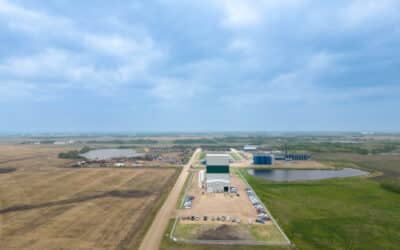The scope of the Accredited Seed Treatment Operation Standards is about to expand. All commercial seed treatment operations, including those treating cereal and pulses, must successfully complete an audit of the standards by Dec. 31, 2020. Non-compliance will be enforced by an industry no-ship policy effective Jan. 1, 2021. Alberta Seed Guidespoke with Russel Hurst, CropLife Canada’s vice-president of sustainability and stewardship, about the journey ahead on the road to standards compliance and the effect implementation will have on industry stakeholders.
ASG: What has the journey been like so far toward implementing the Accredited Seed Treatment Operation Standards?
RH: The whole process has been a unique journey. One of the program’s early drivers was to address environmental, health and safety protocols within the seed treatment sector. We viewed seed treatment, which was a rapidly expanding component within the pesticide sector, as a gap in our stewardship program.
This is a vibrant seed industry. If we have robust environmental, health and safety standards, we can stay away from onerous provincial and federal government regulations: in an ideal world, we can communicate that national standard to provincial ministries of agriculture and the environment and the Pest Management Regulatory Agency at the federal level.
The process may be led by CropLife, but we do a lot of briefings with seed growers, seed cleaning co-ops and seed companies to make sure their wants, needs and desires are met. At the end of the day, maybe not everyone is happy 100 per cent of the time, but we’re looking to this process to answer how we continue to culture a vibrant seed sector.
Generally speaking, we’re fairly happy with how 2018 turned out. By July, 382 facilities across the country, which is the majority of operations, had successfully passed the audit. About three dozen facilities are in the process of finalizing their audits, however, they didn’t get certified for the 2018 seed treatment year. Typically, those were facilities that weren’t treating corn, canola or soybeans, but have aspirations of doing so.
The largest number of certified facilities is in Manitoba, primarily because that’s where a high number of seed growers are located and it’s where the soybean business has expanded significantly over the last couple of years. That number will trend upwards in Saskatchewan and Alberta over time.
Any new facility coming online that wants to treat seed commercially — soybeans, canola, and to a lesser extent corn — in Western Canada, will have to complete an audit.
ASG: What are your observations from the first year of program implementation?
RH: In terms of the lessons we’ve learned from the audit process to date, we’ve had a very low level of compliance and enforcement issues. Individuals who did try to purchase designated seed treatment products from an ag-retailer usually weren’t fully aware of the requirements — it was more misinformation or misunderstanding rather than deliberate non-compliance.
We also learned the audit protocols must be meaningful to mobile seed treaters. When we first started auditing facilities we had a handful of mobile treaters — they were the exception. Within the audit protocols, roughly two-thirds are applicable to mobile treaters.
This fall, the working group will be going through those audit protocols to ensure they’re meaningful to mobile treaters because of the unique way their businesses operate.
We also see continuous improvement to a facility’s ability to do paperwork, training, education and documentation. That’s been the biggest gap throughout the entire process. All operators, and these are incredibly smart people, know their businesses very well. The biggest gap has been showing us that from an audit standpoint, through documentation. This is a work in progress. It’s something we’ll look to improve upon through templates, or by helping people help themselves.
Moving forward, we’ll likely see associations and registrants in the seed treatment business get more involved because they see it as an opportunity to help their members or customers.
One observation that took us by surprise is this process helps governments increase their levels of compliance with regulations, such as provincial licences for example. We can let an operator know they need a licence for X, Y or Z, but we do that in a safe way.
ASG: What is the path forward from now until the end of 2020?
RH: We’ll continue to use the designated seed treatment products list, which will get updated and reissued annually at a minimum. Typically, the list will be updated toward the end of October, as this is the time of year most new registrations coming online for the next crop year are completed. We’ll do this for the seed treatment years 2019 and 2020.
ASG: What happens beyond 2020?
RH: The program is going to change for 2021. The direction from our May CropLife board meeting was to implement phase II of the Seed Treatment Operation Standards program. We’re going to do away with the designated seed treatment products list. All commercial seed treatment operators — if you’re treating seed for sale or gain we deem you a commercial treater — will be required to go through and pass an audit by Dec. 31, 2020, to access seed treatment products. A no-ship policy will be implemented Jan. 1, 2021.
If you’re a farmer treating seed on-farm, continue to do what you’ve been doing. If you’re a commercial treater and you’re treating corn, canola and soybeans, continue doing your audits, you’ve already gone through that checkpoint. If you’re treating cereals or pulses commercially, by 2021 you must complete an audit.
For those seed treatment facilities in the cereals and pulse space, it’s going to be the same journey the corn, canola and soybean operators went through from 2014 to 2018. They’re just going to do it a couple years later.
In terms of preparing the industry for that, some of these sites have already completed a pre-audit as part of phase I. We will go through that same process for phase II of the program.
If you’re a commercial seed treatment facility that hasn’t gone through this process, we highly encourage completing a pre-audit. I am also fairly confident there will be some sort of pre-audit incentive.
The key piece about the pre-audit is the operator has a GAP assessment, so they have an incredibly clear understanding of what they’re doing now and what they need to do to pass an audit.
The message we try to convey is this doesn’t need to be a $10,000 investment, it can be significantly less than that. You just need to identify as an operator what best fits your operation. We do that as part of the pre-audit. We also supply templates for facilities, and we build a binder: we’ll provide the operator with the facility’s documentation requirements. Basically, operators need to fill in the blanks. They need to make it meaningful for their operations.
The purpose of the build-a-binder is for operators to understand the risks unique to their operations, to develop mitigation strategies and to understand where the risks impact them. It’s a journey sites go on of self-identification and things they can do to improve the environmental, health and safety impact of their operations.
The reality is, these types of programs aren’t going away: if we didn’t do it, there’d be government regulations in one form or another. It allows us to create our own destiny.
ASG: How does implementation of phase II affect industry stakeholders?
It gives farmers purchasing commercially treated seed an assurance that as of 2021 all facilities across the country, and currently the ones treating the noted commodities, adhere to an industry level of best practice. Farmers benefit from consistent, high-performing products, which in turn protects their investments.
Regulators benefit because their needs are being heard. And if when we act on those needs we’re doing it in a manner that is implementable and reasonable, they’re happy.
From the standpoint of commercial seed treatment operators, after they’ve gone through the process, I believe everyone will feel their operations were improved. Registrants will have an assurance their products are being used correctly from an environmental, health and safety aspect. Also, that their products are going to perform in the field — and for them that’s the holy grail.






